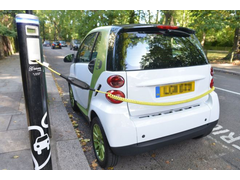
Electric Cars and Charge Leads
907 - 17/10/16 at 04:30 PM
I was browsing BBC news at lunchtime and a photo of an electric car on charge in the street caught my eye.
Knowing how long it takes to charge a 12v car battery (hours & hours) just to get enough energy to turn an engine over
for a minute or two, and at the other end of the scale having worked in industry, seeing the size of an electric forklift charger
and the 400 amp cables that connect it overnight, I am puzzled by this picture.


Description
This looks like my electric shaver lead, or at best a wire for a 12" Flymo.
I would have thought that the energy needed to power a car 50 miles or so required a cable of a half decent size
with a hefty torpedo plug on the end; or am I just an old fart who hasn't grasped this technology yet?
Paul G
nick205 - 17/10/16 at 04:48 PM
Paul,
I'm 42 and familiar with both car battery chargers and industrial fork lift chargers. Both take considerable time to pass the energy and
certainly industrial fork lift power leads are pretty beefy.
Like you the image does make me wonder how you can safely pass sufficient current to charge an EV - in a short space of time?
Personally I see charging "infrastructure" development as the stumbling block for EVs. In public car parks (for example) the power
distribution and wiring requirements would be considerable. No doubt standards would evolve and so would connectors and technology - it seems quite a
potential minefield to me.
02GF74 - 17/10/16 at 05:30 PM
Aerent you assuming its 12v dc.
If say it was 120 v dc (it could be ac) it can carry 10x current that 12 v charger can.
Id be surprised if electrick cars used 12v power.
cliftyhanger - 17/10/16 at 05:36 PM
^^^not true (being pedantic) but 120v against 12v can carry 10x the power. The max current will be the same. But when the voltage is reduced down to
12v THEN the current would be greater
However, I have no idea what voltage the chargers supply, but thinking about it, it would make sense if it was normal mains voltage 220v? And the
appropriate transformer would be in th ecar meaning heavy cable runs would be kept to a minimum. And more flexibility regarding the charging voltage
of the battery.
That cable looks about 16A to my eye....
Anybody know about this stuff?
coyoteboy - 17/10/16 at 05:41 PM
EV batteries run at hundreds of volts. At 240v a 13a socket gives you 3.1kw. At 12v you would need 260A to hit the same energy transfer. And most EV
stations are dedicated 32A supplies so 7.7Kw. That would charge your car battery in less than 2 hours if it could withstand the heat input. Not to
mention some EV packs are 500V so at 240v stepped up it might only be 16A out the far end, so a hefty kettle lead could cope.
big-vee-twin - 17/10/16 at 06:31 PM
They are at mains voltage
JoelP - 17/10/16 at 06:33 PM
I seem to recall that the battery in an electric car lasts longer (in terms of lifetime) if you charge it slowly at 13a, rather than the fast charge
option. Memory tells me that 13a is an overnight job to fill it, but that would only need a 2.5mm 3 core flex. The cable in the picture is probably
custom made for the application, but if it was a 4mm 3 core it could deliver 32a no problem.
iirc electric car batteries are about 400v.
B33fy - 17/10/16 at 09:41 PM
Depends on the car, there are a number of "types" and "levels" Chargers are specific types and work at a number of levels which
are automatically defined by the charger and car. My Mercedes for example is type 2 and will charge at either 8 or 16 amps. My type 2 home charger
will charge at 16 or 32 amps, though will only do 16 amps when plugged into the Merc. I can charge at 8 amps using a supplied trailing lead plugged
into a 13 amp socket though some say the socket gets a bit warm.
Other cars/chargers can do DC and three phase along with various voltages, all a bit of a minefield TBH.
02GF74 - 18/10/16 at 09:57 AM
quote:
Originally posted by cliftyhanger
^^^not true (being pedantic) but 120v against 12v can carry 10x the power. The max current will be the same. f?
Youre not being pedantic, i mean to write power not current. My bad
DJT - 18/10/16 at 11:26 AM
quote:
Originally posted by nick205
Paul,
I'm 42 and familiar with both car battery chargers and industrial fork lift chargers. Both take considerable time to pass the energy and
certainly industrial fork lift power leads are pretty beefy.
Like you the image does make me wonder how you can safely pass sufficient current to charge an EV - in a short space of time?
Personally I see charging "infrastructure" development as the stumbling block for EVs. In public car parks (for example) the power
distribution and wiring requirements would be considerable. No doubt standards would evolve and so would connectors and technology - it seems quite a
potential minefield to me.
I do wonder about the infrastrucute too. Then again, I recently learned that the regulations our new office build is subject to stipulate 20% of
spaces must be for electric cars. Will be very interesting to see the level of uptake (from 0% in our current building today).


